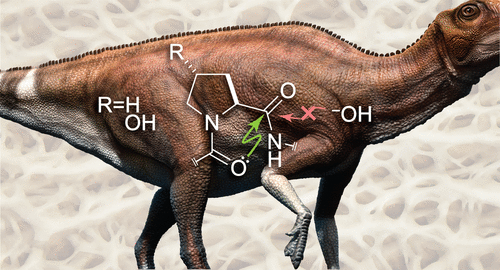Collagen is the most abundant protein in animals. It is also one of the most enduring. Over the past few decades, paleontologists have found it in dinosaur fossils tens of millions of years old.
Its persistence is perplexing, because the protein contains chemical bonds, that, on paper, should only last 500 years. So why does this stuff last so long? Chemists provide an answer to that mystery in an ACS Central Science report.
The Strength of Collagen
The answer starts with collagen’s structure. Collagen consists of three protein strands that essentially twist together to form a substance much stronger than each strand.
“Collagen strands form a triple helix,” says Ron Raines, a chemist at the Massachusetts Institute of Technology and an author of the paper. “That triple helix is a remarkable structure that has served as the scaffold for animal bodies for (at least) 200 million years. I wonder if the evolution of the collagen triple helix was enabling for animal life to emerge on Earth approximately 1 billion years ago!”
However, even the strongest rope wears, frays, and eventually snaps over time. So why doesn’t collagen?
Read More: Analysis of Bone Helps Explain Why It’s So Strong
How Collagen Resists Water
That’s the mystery at the center of collagen’s longevity. Amino acids — which form each strand of the collagen rope normally break down when exposed to water, just like normal rope gets weathered by rain. For some reason, the peptide bonds (essentially the chemical glue that holds the strands together) that connect amino acids in collagen don’t break down when wet.
To investigate why not, the chemists designed and synthesized small molecules that enabled them to test how they reacted to neighboring peptide bonds in collagen.
“In essence, we could ‘turn on’ or ‘turn off’ that interaction and then observe the results,” says Raines. They were especially intent on observing hydrolysis — the process that breaks down chemicals by water.
“We found that turning on the interaction prevented hydrolysis,” says Raines.
Read More: Fossilized Dinosaur Eggshells Can Preserve Amino Acids Over Millions Of Years
Electron Sharing and the Pauli Exclusion Principle
The how is a bit esoteric, since it involves a quantum mechanical effect called the “Pauli exclusion principle.”
The principle states that an orbital in a molecule can be occupied by up to two electrons, not more. Because the components of collagen share electrons throughout its structure, there’s essentially no room for electrons in a water molecule to mess with the bonds.
“Collagen is unique in allowing this neighborly sharing of electrons throughout its structure,” says Raines. “No other protein is protected likewise from hydrolysis.”
So now that we know why our collagen-heavy bones and cartilage are so tough, what can scientists do with that information? The researchers have already shown how to engineer similar bonds, so that they are vulnerable to water — including in biodegradable cutlery.
“Related applications are certainly possible!” says Raines.
Read More: First Observation of a Pauli Quantum Crystal
Article Sources
Our writers at Discovermagazine.com use peer-reviewed studies and high-quality sources for our articles, and our editors review for scientific accuracy and editorial standards. Review the sources used below for this article:
Before joining Discover Magazine, Paul spent over 20 years as a science journalist, specializing in U.S. life science policy and global scientific career issues. He began his career in newspapers, but switched to scientific magazines. His work has appeared in publications including Science News, Science, Nature, and Scientific American.
Source : Discovermagazine











